What Exist In The Community Service Of Temple Terrace
| Temple Terrace, Florida Tree City U.s.a. | |
|---|---|
| City | |
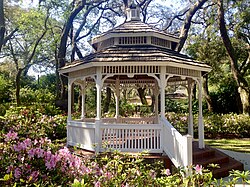 Gazebo at Woodmont Park | |
| Nickname(s): "The Terrace" | |
| Motto(southward): "Amazing City, Since 1925" | |
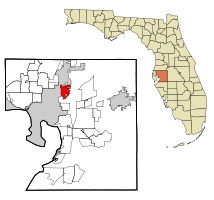 Location in Hillsborough Canton and the U.S. country of Florida | |
| Coordinates: 28°02′07″N 82°23′21″W / 28.03528°Northward 82.38917°W / 28.03528; -82.38917 Coordinates: 28°02′07″N 82°23′21″W / 28.03528°N 82.38917°W / 28.03528; -82.38917 | |
| Country | |
| State | |
| County | |
| Urban center | |
| Founded | 1920 |
| Incorporated | May 28, 1925 |
| Authorities | |
| • Mayor | Andy Ross |
| • City Managing director | Charles W. Stephenson |
| Expanse [1] | |
| • Total | vii.77 sq mi (20.13 km2) |
| • Country | seven.47 sq mi (xix.36 kmii) |
| • Water | 0.thirty sq mi (0.77 kmtwo) |
| Elevation | 59 ft (18 k) |
| Population (2020) | |
| • Full | 26,690 |
| • Density | three,570.57/sq mi (1,378.57/kmii) |
| Time zone | UTC-five (Eastern (EST)) |
| • Summer (DST) | UTC-iv (EDT) |
| Cypher codes | 33617, 33637, (33687 P.O. Box) |
| Area code(south) | 813 |
| FIPS code | 12-71400[2] |
| GNIS characteristic ID | 0292103[iii] |
| Website | www |
Temple Terrace is an incorporated city in northeastern Hillsborough County, Florida, United States, side by side to Tampa. Equally of the 2020 demography, the urban center had a population of 26,690. It is the third and smallest incorporated municipality in Hillsborough County. (Tampa and Plant City are the others.) Incorporated in 1925, the community is known for its rolling landscape, bucolic Hillsborough River views, and majestic trees; it has the grandest sand live oak trees of any place in key Florida and is a Tree City U.s.. Temple Terrace was originally planned in the 1920s Mediterranean-Revival golf game course customs and is i of the beginning such communities in the United States (planned in 1920).

2011 Temple Terrace entry tower, 56th Street

Glen Burnie Ave. looking south toward Glen Arven
Temple Terrace was named for the then-new hybrid, the Temple orangish as well chosen the tangor. Information technology is a cantankerous between the mandarin orange—besides called the tangerine—and the mutual sweet orange; information technology was named after Florida-born William Chase Temple, one-time owner of the Pittsburgh Pirates, founder of the Temple Cup, and outset president of the Florida Citrus Exchange. Temple Terrace was the start place in the Usa where the new Temple orange was grown in large quantities. The "terrace" portion of the name refers to the terraced terrain of the area by the river where the city was founded. One of the original houses also had a terraced thousand with a backyard sloping, in tiers, toward the river.

Rolling Temple Terrace landscape, photo circa 1923
History [edit]
Pre-Columbian [edit]
The original inhabitants of the Temple Terrace surface area were known as the Tocobaga, a group of Native Americans living around Tampa Bay, both in prehistoric and historic times, until roughly 1760. Their numbers declined in the seventeenth century, due at least in function to diseases brought to the New Globe past the Europeans, to which they had little natural resistance. All of the Florida tribes were too severely affected by the raids of Creeks and Yamasee during the tardily stages of the seventeenth century. In whatsoever case, the Tocobaga disappeared from history less than a hundred years subsequently.
Spanish exploration [edit]

The earliest known map of the Tampa Bay surface area. Information technology is past Spanish explorer Don Francisco Maria Celi of the Castilian Royal Armada, 1757. This copy is from the South Florida History Museum; the original is in the Museo Naval de Madrid, Spain. The river on the upper left of the map is the Hillsborough, and the area designated equally "El Pinal de la Cruz de Santa Teresa" is today in Temple Terrace. "El Salto" are the rapids at Hillsborough River Country Park, where the journey concluded. The map is oriented so that east is to the tiptop.

1920s Temple Terrace postcard
Spanish exploration of the Temple Terrace area dates back to 1757 when explorer Don Francisco Maria Celi of the Spanish Royal Fleet made his style upwards the Hillsborough River (naming it "El Rio de San Julian y Arriaga") to what is now Riverhills Park in search of pine trees to use as masts for his ships. Here, in the extensive longleaf pino forest, he erected a cantankerous in what he named "El Pinal de la Cruz de Santa Teresa" (the Pine Woods of the Cross of Saint Theresa). Confirmation of the fleet'south travels is found in its map and logbook. A celebrated marker and a replica of the cross erected to accolade St. Theresa are institute in Riverhills Park today. Up to 1913, the longleaf pine, sand live oak, and cypress trees made the area suitable for turpentine manufacturing and logging.
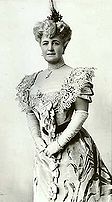
The Potter Palmer years [edit]
The expanse now known as Temple Terrace was originally part of an exclusive 19,000-acre (77 km2) game preserve called "Riverhills" belonging to Chicago socialite Bertha Palmer, wife of man of affairs Potter Palmer. She played an extensive role in making Sarasota the "Urban center of the Arts" that it is today. She was 1 of the largest landholders, ranchers, farmers, and developers in Florida at the turn of the twentieth century. The Evening Independent newspaper in 1918 described the preserve as "a well-stocked hunting preserve north of Tampa being 1 of the most attractive hunting grounds in the state." Property acquisition past the Palmers and the Honorés began in 1910; only one of the original buildings from the preserve, now known as the Woodmont Clubhouse, remains. Because it escaped logging, the grounds of the clubhouse harbor some of the largest specimens of live oak and longleaf pine in the city.
[edit]
Mrs. Potter-Palmer'southward vision for her holding was that it be adult into a golf course community surrounded by extensive citrus groves, but her expiry in 1918 prevented her from fully realizing that vision. At her death, the trustee of her estate and blood brother, Adrian Honoré, sold her local country holdings to Burks Hamner,

Longleaf Pine woods: 1921 Burgert Brothers photo of Temple Terrace pre-development
Vance Captain, Maud Fowler, Cody Fowler, and D. Collins Gillett, who formed two evolution corporations: Temple Terrace Estates, Inc., which developed the golf course and residential areas; and Temple Terraces, Inc., which developed 5,000 acres (20 km2) of orange groves that originally surrounded the metropolis to the due west and north, the largest orange grove in the world in the 1920s. (Adrian Honoré retained a seat on the board.) D. Collins Gillett oversaw Temple Terraces, Inc. and owned the get-go and largest citrus nursery in Florida, Buckeye Nurseries of Tampa. His father, Myron E. Gillett, thirty-first mayor of Tampa, was instrumental in popularizing the exotic hybrid Temple orange in the United States.
The 1920 vision for the customs was that wealthy retired Northerners would buy one of the lots in Temple Terrace, build a Mediterranean Revival villa on the lot and besides buy a packet in the extensive adjoining citrus grove to either manage as a hobby or provide extra income. Temple Terrace was originally only occupied during "The Season" (which lasted roughly from Dec to the almanac Washington Ball held at the clubhouse on February 22). For the residual of the year, the houses were cared for by caretakers until The Season came again and the homeowners returned.
In 1924, part of the 5,000-acre (20 kmtwo) area platted as the Temple Orangish grove and called Temple Terraces, Inc. was adult into the nowadays-day neighborhood of Temple Crest, immediately adjacent to Temple Terrace and its west, hugging the Hillsborough River. The land occupied past nearby Busch Gardens was also part of Mrs. Palmer'due south original nineteen,000-acre (77 km2) ranch.
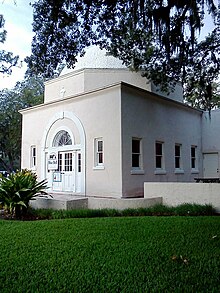
Temple Terrace Community Church

1920s postcard of the "World's Greatest Citrus Grove"
In 1925 and 1926, the Temple Terrace Golf and Country Club (which is still in being) hosted the Florida Open (in 1925 billed as the "Greatest Field of Golfers ever to Play in Florida"). "Long" Jim Barnes was the resident professional of the form at the time (James Kelly Thomson was the form'south first pro), and every major golfer of the day competed in the consequence except for Bobby Jones. Leo Diegel won the tournament. Jim Barnes' friend Fred McLeod is also associated with the early on days of the course. The golf-course builder was Tom Bendelow, who also designed Medinah Country Gild'due south Course #3 in Chicago, a 7,508-yard (7,385 m) golf game course that has hosted three U.S. Opens (1949, 1975, 1990) and 2 PGA Championships (1999, 2006). The golf class of the Temple Terrace Golf and State Club is virtually unchanged since its design by Bendelow and is eligible for the National Register of Celebrated Places. It measures 6,414 yards with a par of 72.
Temple Terrace is one of the first planned golf-class communities in the The states (1920). The boondocks plan was created by town planner and landscape architect George F. Young, who too created the plan for nearby Davis Islands (Tampa) and McClelland Park (Sarasota), amongst others. The compages was designed in the Mediterranean-Revival mode by two different architects in two dissimilar periods. The get-go phase was in 1921 past noted Tampa architect One thousand. Leo Elliott (Centro Asturiano de Tampa and Quondam Tampa City Hall) designed the initial houses and the public buildings. In 1926 renowned New York builder Dwight James Baum (architect of John Ringling's Cà d'Zan, the Hotel El Verona in Sarasota, and the West Side YMCA in New York Urban center) also designed residences in Temple Terrace.

The Vision: 1922 Temple Terrace Principal Program (looking northwest). Recently discovered colorized photo showing the "globe's largest citrus grove in the 1920s" (v,000 acres (20 km2) of Temple oranges) to the westward and north surrounding the village. The Hillsborough River is in the foreground; the Bullard Parkway bridge crosses the river; 56th Street does non however exist, only Nebraska Avenue is on the left horizon.

Mid-Century Modern architecture in Temple Terrace
There are fifteen houses and buildings designed by Elliott remaining in the city, the largest collection of his piece of work anywhere. In add-on, at that place are over 35 houses in the urban center designed past architect Dwight James Baum, which is thought to exist the largest collection of his work in the Southeast.
Temple Terrace struggled through the 1930s like the rest of Florida. Building activity began to option upwards once again after World State of war Two. There is at present a fine collection of mid-century modernistic homes and buildings, at least two of which were designed past well-known architect Frank Albert DePasquale.
Florida Higher [edit]
Florida Bible Found bought the sometime Country Club Clubhouse in the belatedly 1930s from the urban center for back taxes and remains a cherished part of Florida College. Florida College is now a private liberal arts college (founded in 1946) and occupies some of the community's oldest buildings, including the Temple Terrace Country Gild, which is now Sutton Hall. Billy Graham attended Florida Bible Institute, which owned the property now occupied by Florida College, in the tardily 1930s. In his autobiography, he writes that he received his calling "on the 18th green of the Temple Terrace Golf and Country Club". A Baton Graham Memorial Park is on the east side of the 18th green on the river.
Rejuvenation and redevelopment [edit]
Temple Terrace's rebirth took identify in 1984–1987 with the appointment of Thomas C. Mortenson as the Urban center'southward Edifice and Zoning Director and 1st Community Development Director [ane]. Mortenson, with the assistance of Metropolis Engineer Paul Tomasino, and Metropolis Attorney Ted Taub, were responsible for the annexation of Telecom Park and numerous areas adjacent to the city, thereby tripling the tax base of operations and doubling the size of the city. Creating a favorable development environment and working with the Mayor and Urban center Council, the trio worked to attract new businesses, and shopping centers, too every bit redevelopment of existing concern areas and vastly expanded housing in the community. Numerous new subdivisions were created during this period giving the urban center a firm tax base and identity that made Temple Terrace a desirable safe place for raising families, conducting business, and an environmentally audio community [2].
Temple Terrace is currently in the process of redeveloping l acres (200,000 g2) (the southeast quadrant) of its 1960s-era downtown. The goal of the city is to build a mixed-use, medium-density, pedestrian-oriented downtown.
The urban center hired noted town planner Torti Gallas + Partners in 2004 to create a New Urbanist principal program and redevelopment code for the unabridged 225-acre (0.91 km2) downtown surface area (four quadrants of 56th Street and Busch Boulevard), all with citizen input. The metropolis too initiated a form-based code for its downtown, created a façade-improvement grant program, implemented a multi-modal transportation model to encourage alternatives to the automobile, and began revitalizing 56th Street with entry towers, landscaping, street piece of furniture, placing utilities underground, and improved lighting.
The site of the new downtown area is the site of the downtown surface area that was originally planned in the 1920s but never built because of the Groovy Depression. Many of the planning concepts and architecture of the redevelopment area are based on the original plan and Temple Terrace's unique 1920s historic Mediterranean Revival architecture.
Neighbors [edit]
Many of Temple Terrace's residents teach or piece of work at the nearby University of South Florida, and the shut-knit community has potent ties to that institution. (The USF campus was also part of Mrs. Palmer's original nineteen,000-acre (77 km2) ranch.)

Don Francisco Maria Celi plaque at Riverhills Park
Eureka Springs Park, located to the eastward of Temple Terrace, is Hillsborough Canton'due south but botanical garden. The 31-acre (130,000 thou2) park was started past Russian immigrant and amateur horticulturalist Albert Greenberg, who donated his park to the county in 1967. Poet Robert Frost and other famous personalities made it a point to visit Greenberg in the years before Globe War II.
The Museum of Science & Industry, unremarkably called MOSI, is located in Tampa near the Temple Terrace metropolis line.
Sitting just one mile to the w of Temple Terrace is Busch Gardens Tampa.
Geography [edit]

Hillsborough River at Riverhills Park
Temple Terrace is located in n-central Hillsborough County at 28°ii′xxx″Northward 82°22′57″W / 28.04167°North 82.38250°W / 28.04167; -82.38250 (28.041546, –82.382519).[four] The city is divisional by Tampa to the westward and due north, Del Rio to the south, and rural Hillsborough Canton, almost Interstate 75, to the east.
According to the United States Demography Bureau, the city has a total area of 7.i square miles (18.iv km2), of which half dozen.eight square miles (17.7 km2) are country and 0.3 square miles (0.vii kmtwo), or 3.70%, are h2o.[5] The Hillsborough River flows through the eastern and southern parts of the city and forms some of its southern boundary.
Demographics [edit]
| Historical population | |||
|---|---|---|---|
| Demography | Pop. | %± | |
| 1940 | 215 | — | |
| 1950 | 433 | 101.4% | |
| 1960 | iii,812 | 780.iv% | |
| 1970 | seven,347 | 92.seven% | |
| 1980 | 11,097 | 51.0% | |
| 1990 | 16,444 | 48.2% | |
| 2000 | 20,918 | 27.2% | |
| 2010 | 24,541 | 17.3% | |
| 2020 | 26,690 | eight.eight% | |
| U.South. Decennial Census[6] | |||
As of the census of 2010,[7] there were 24,541 people living in the city. The racial makeup of the urban center was 68.04% White, 19.53% Black, 0.07% Native American, 5.45% Asian, 0.04% Pacific Islander, 3.30% from other races, and 3.17% from ii or more races. Hispanic or Latino of whatever race were 14.66% of the population.[ citation needed ]
Per city data, 90.5% of the population has a high school degree or higher. 43.v% of the population has a bachelor's degree or higher. 17.iii% of the population has a graduate or professional degree. These are the highest instruction percentages of any municipality in Florida.[ citation needed ]
There were 8,671 households, out of which 27.9% had children under the age of 18 living with them, 46.9% were married couples living together, 11.4% had a female householder with no husband present, and 38.iii% were non-families. 28.ix% of all households were made up of individuals, and eight.three% had someone living lone who was 65 years of age or older. The average household size was 2.36 and the average family unit size was ii.95.
In the city, the population was spread out, with 22.ii% under the age of 18, 12.iv% from eighteen to 24, 29.9% from 25 to 44, 23.five% from 45 to 64, and 11.9% who were 65 years of age or older. The median age was 35 years. For every 100 females, in that location were 91.4 males. For every 100 females historic period xviii and over, there were 87.ii males.
The median income for a household in the city was $44,508, and the median income for a family was $56,809. Males had a median income of $38,384 versus $32,107 for females. The per capita income for the urban center was $26,515. Well-nigh 5.4% of families and vii.2% of the population were below the poverty line, including 5.eight% of those under age eighteen and 8.9% of those age 65 or over.
Notable people [edit]
- Pam Bondi, 37th Florida Attorney General
- Sammy Ellis, professional person baseball bullpen
- Cody Fowler, prominent Florida chaser and one-time President of the American Bar Clan
- Napoleon Hill, motivational writer and speaker
- Peter Palmer, actor
- Colonel Tom Parker, Elvis Presley'south manager
- Robin Roberts, Hall of Fame baseball game pitcher (Philadelphia Phillies)
Pedagogy [edit]
- Temple Terrace Elementary
- Riverhills Elementary
- Lewis Elementary
- Terrace Community Heart School
- Angelo 50. Greco Middle School
- C. Leon King High Schoolhouse
- Dr. Kiran C. Patel Loftier Schoolhouse
- Florida College Academy (private school)
- Temple Terrace Presbyterian Weekday School
- Corpus Christi Catholic School
- Florida College
Library [edit]
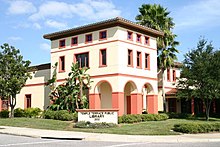
Temple Terrace Public Library
The Temple Terrace Public Library is located at 202 Bullard Parkway in the Urban center of Temple Terrace and is office of the Hillsborough County Public Library Cooperative (HCPLC).
History [edit]
The Temple Terrace Library was established in 1959 by the Temple Terrace Women's Guild. The doors officially opened on January 15th, 1960 after pursuing a collection of enough donations to facilitate a small-scale library for the customs. It was originally run past volunteers of the Women's Guild and was located in a small business firm. As demand grew, they relocated to a Metropolis Hall edifice in April of 1961, which is now part of Florida Higher. The library shortly outgrew this likewise as they congenital their collection and past 1965 they needed a new building and a larger overall functioning which included appointing a Library Board which was run by the city. They broke ground in September of that year and opened in April of 1966. The Women's Gild remained involved and provided the money for the library's service desk. By the mid-70'south they were running out of space and added 5,600 foursquare feet which enlarged the structure by April 1978. On February 18th, 1982 tragedy ensued when a burn down was set past an arsonist. The library lost a devastating 11,666 books and 1,010 recordings. The Women's Club stepped in again and helped restore the building which and so opened a twelvemonth after the fire. In the concurrently, they relocated materials to the Lightfoot Recreation Eye to proceed the library going. In 1997 the library was once more renovated for expansion which brought the library to 20,000 square feet. It reopened in March 1998 with an online catalog, computers, and internet access which is largely how information technology is utilized to this day with a collection of over 100,000 volumes and 52 community computers. [8]
Services [edit]
Services include a standard book, eBook, CD, and DVD checkout. There is admission to computers, Wi-Fi, and other technologies likewise as regular and 3D printing. There are meeting and study rooms, prophylactic areas for children, and a Book Nook provided past the local Friends of the Temple Terrace Library system. At that place are programs for children, teens, and adults which include activities and resources for certain age groups and developmental levels ranging from storytime to crafts and appropriate games. The library as well offers many resources beyond books such as sewing machines, cooking items, tools, board games, and neckties to borrow for diverse reasons. You can even "check out" a express number of seed packets each month that does non accept to be returned and come with instructions on how to accept care of them. These are all resource that have been proven to exist successful in the local community to assist provide items that may only occasionally be needed. Partnering up with the University of South Florida Special & Digital Collections and Tampa-Hillsborough County Libraries, the Temple Terrace Library has besides been able to provide access to archives of the local newspapers, the Temple Terrace Beacon and Temple Terrace Lookout. [9]
Sister cities [edit]
Temple Terrace has a sister city:
-
 Eastleigh, England, in the Great britain since 1989 [10] [xi]
Eastleigh, England, in the Great britain since 1989 [10] [xi]
References [edit]
- ^ "2020 U.S. Gazetteer Files". United states of america Census Bureau. Retrieved Dec 2, 2021.
- ^ "U.Southward. Census website". United states of america Census Bureau. Retrieved January 31, 2008.
- ^ "US Board on Geographic Names". U.s. Geological Survey. October 25, 2007. Retrieved Jan 31, 2008.
- ^ "US Gazetteer files: 2010, 2000, and 1990". U.s.a. Census Bureau. Feb 12, 2011. Retrieved April 23, 2011.
- ^ "Geographic Identifiers: 2010 Demographic Profile Data (G001): Temple Terrace city, Florida". American Factfinder. U.South. Census Bureau. Retrieved May i, 2017. [ dead link ]
- ^ "Census of Population and Housing". Demography.gov. Retrieved June 4, 2015.
- ^ http://censusviewer.com/city/FL/Temple%20Terrace
- ^ "Library History | Temple Terrace, FL - Official Website". www.templeterrace.com . Retrieved Nov 28, 2021.
- ^ "Library | Temple Terrace, FL - Official Website". www.templeterrace.com . Retrieved Nov 28, 2021.
- ^ "City of Temple Terrace News Release" (PDF).
- ^ Eastleigh Borough Council (2011). "Eastleigh Borough Council: Twin Towns". eastleigh.gov.uk. Archived from the original on July 23, 2011. Retrieved May 20, 2011.
Further reading [edit]
- Lana Burroughs, Tim Lancaster, Grant Rimbey (2010). Temple Terrace. Arcadia Publishing. ISBN978-0-7385-8654-0.
{{cite volume}}: CS1 maint: uses authors parameter (link) - Cleo Northward. Burney (1975). Temple Terrace: The Start Fifty Years. Temple Terrace, Florida: Friends of the Temple Terrace Public Library.
External links [edit]
- City of Temple Terrace official website
- U.South. Geological Survey Geographic Names Data System: Temple Terrace, Florida
What Exist In The Community Service Of Temple Terrace,
Source: https://en.wikipedia.org/wiki/Temple_Terrace,_Florida
Posted by: emersonroince.blogspot.com


0 Response to "What Exist In The Community Service Of Temple Terrace"
Post a Comment